



















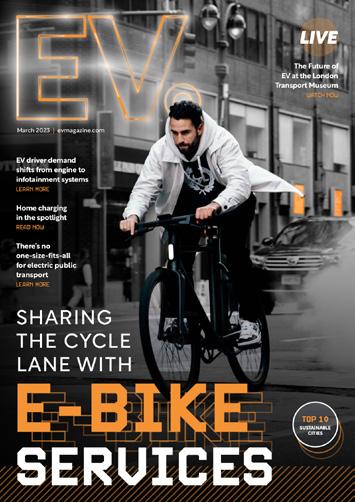



































EV magazine is an established and trusted voice with an engaged and highly targeted audience of over 1,500 global executives
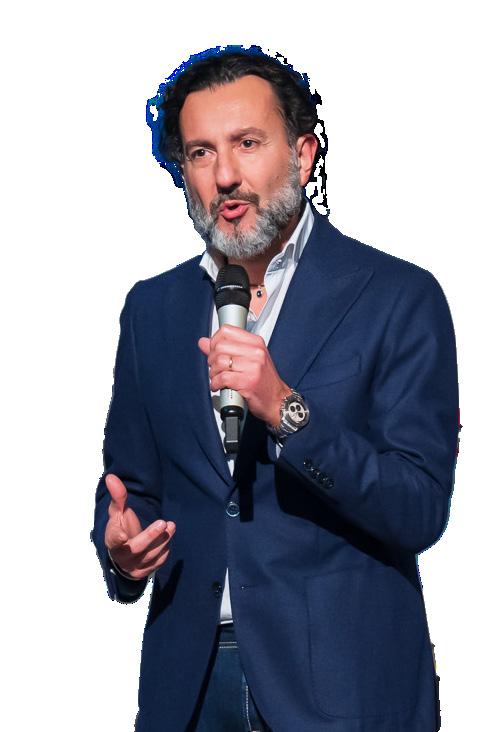








Digital Magazine

Website Newsletters
Industry Data & Demand Generation


Webinars: Creation & Promotion
White Papers & Research Reports
Lists: Top 10s & Top 100s
Events: Virtual & In-Person
WORK WITH US


Now that we’ve extensively covered these key topics in the e-mobility arena, it’s nice to branch out from the discussions of Tesla’s latest endeavours or consumer sentiments towards the latest roadworthy electric automobiles. These are very crucial, but there is a whole world out there that requires zero-emissions solutions, and areas untouched by electrification—until now.
This issue of EV Magazine looks firstly at the UIM E1 Series World Championship— yet to begin, but is very much in the race towards climate positivity. Experts in the team designing, building, and enabling the race tell us what exactly to expect from the marine competition format.
Beyond this, we’re looking at further initiatives, such as battery swapping and its place in the future—providing batteryas-a-service to customers. Also, off-road utility capabilities of electric that are yet to be discovered. And, recognising that e-mobility is still very much a technology game, consultants share more insight into the much-anticipated capabilities from V2G connectivity.
TOM SWALLOW EDITOR-IN-CHIEF tom.swallow@bizclikmedia.com
AND WATER: ONCE RESISTANT, NOW COMPATIBLE
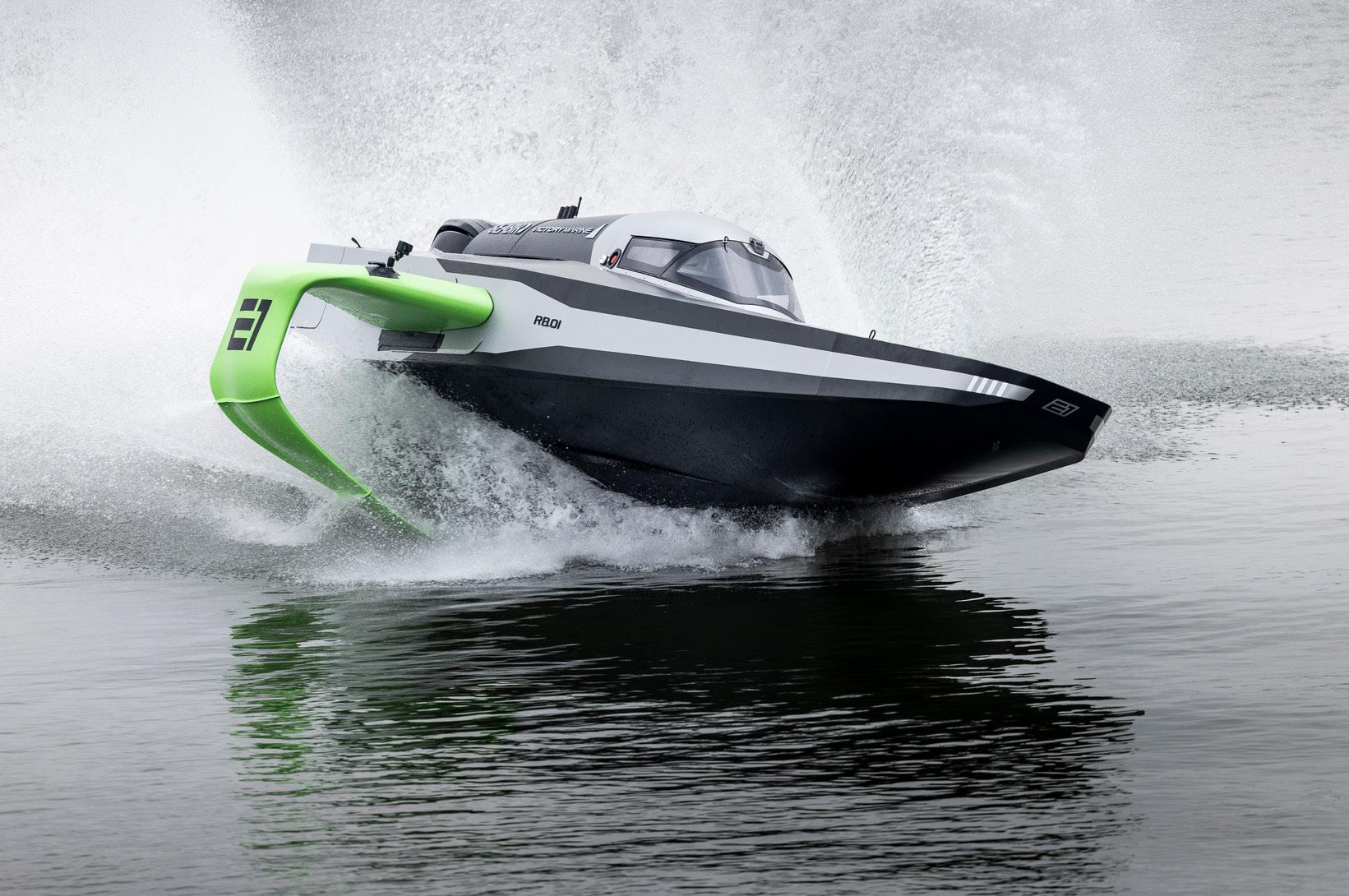



024
080 TOP TEN E-mobility service providers







EVs make up a significant portion of the sustainability mobility conversation, but more hydrogen innovation is creeping into the news as businesses develop alternative ways to achieve net-zero emissions in transport.
To operate fuel-cell vehicles, a supply chain of hydrogen is needed – a key requirement before countries can even consider this option on a wider scale. Natural gas is currently the primary source of hydrogen production, accounting for around 75% of the total 70 million tonnes provided annually.

A further percentage of the hydrogen fuel is extracted from coal, and a small amount from the use of oil and electricity.

Hydrofoils lift a boat's hull out of the water, reducing drag to boost speed and efficiency. Working like aeroplane wings, using hydrodynamic lift, each hydrofoil consists of a wing-shaped foil beneath the boat's hull, with a curved top and flat or slightly curved bottom. When the boat moves, water flowing over and under the foil creates lift.
The lift results from pressure differences between the top and bottom surfaces. The curved top accelerates water, creating lower pressure, while the flatter bottom slows water, causing higher pressure. This pressure disparity generates an upward force that lifts the hull.
By raising the hull out of the water, hydrofoils decrease drag caused by water contact, enhancing the boat's speed and efficiency. Reduced drag enables higher speeds with the same power or lower fuel consumption compared to traditional hull designs. Hydrofoils often include control surfaces, similar to aeroplane wings, for lift and stability adjustment. These surfaces, such as flaps or trim tabs, modify the hydrofoil's lift and pitch, ensuring manoeuvrability and stability.
Hydrofoils find use in various watercraft, including high-speed ferries, racing boats, sailboats, and personal watercraft. They offer benefits such as increased speed, improved fuel efficiency, smoother rides in rough waters, and reduced hull resistance. Nonetheless, precise engineering and design are crucial for stability and safety, particularl at high speeds.
Beyond boating, hydrofoils are even used in some less conventional products, such as surfboards, providing a unique leisure experience for use on calmer waters.





The boat built for the UIM E1 Series is driving action through excitement and electric propulsion innovation that could change the game for boat makers

The UIM E1 Series is the catalyst boat racing world championship, shedding light on the RaceBird as a masterpiece of design and innovation. But there’s more to the boat’s creation than meets the eye, with its developers having the potential to apply these lessons to the wider watercraft industry.
The name given to SeaBird Technologies’ masterpiece of electrified engineering is influenced by the way it seemingly soars above the water. Leveraging advanced hydrofoil technology, the RaceBird is designed to minimise contact with the water to minimise drag, allowing more efficiency and speed from a smaller battery.


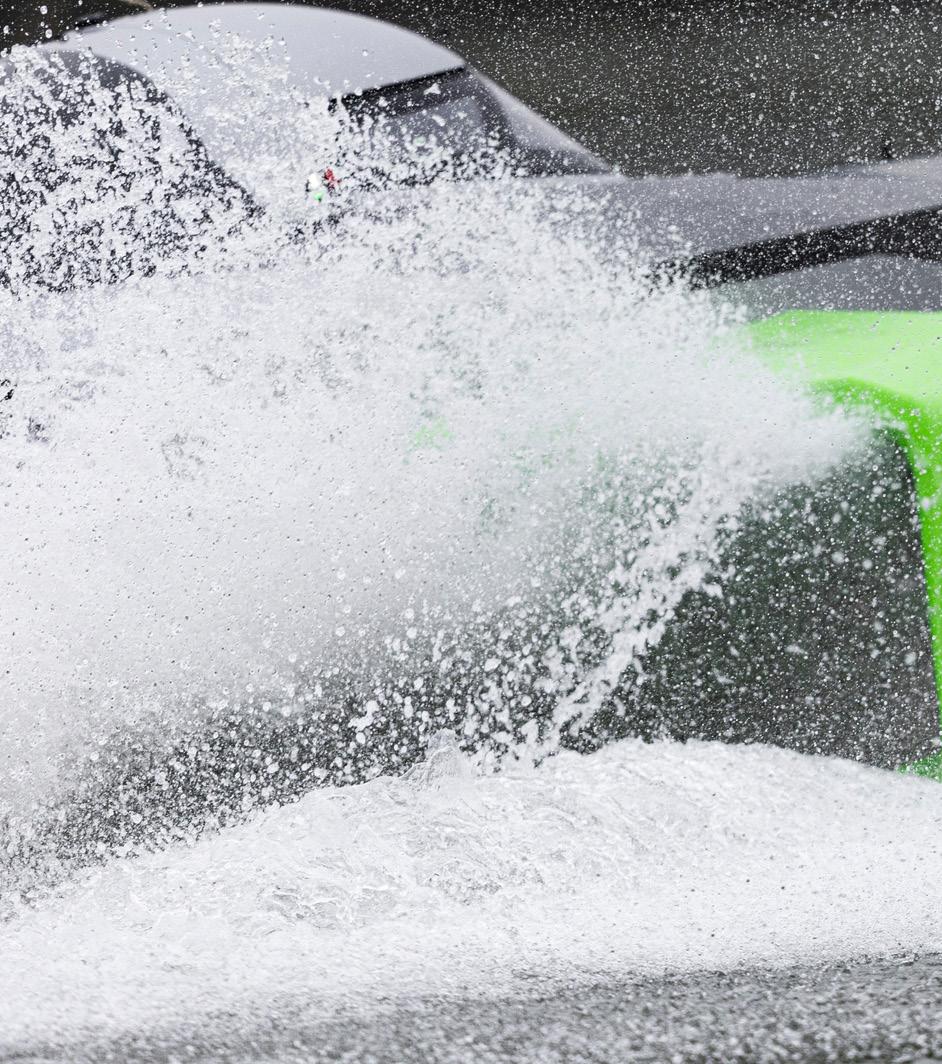
Width: 3.4m
Length: 7.5m
35kWh
50 knots (57-58mph equivalent)
Already in testing, the RaceBird is driven by a propeller with a 150kW motor possessing a maximum speed of 7,000rpm. The battery pack used to power the outboard motor is a 35kWh lithiumion battery built by Kreisel Electric, which was built specifically for the boat. The other components in contact with the water when racing are the side and rear adjustable hydrofoils – which protrude the surface of the water by 90cm.
From a technology perspective, the RaceBird is revolutionary as a machine for powerboat racing because it leverages the instant torque and acceleration that comes with any electric motor. But there is even more to the boat than this, as it can be raced with significantly reduced wave creation, making it less disruptive to the coastline and habitats around it.


We meet Matt Galvin, Managing Director of NIO UK, to learn more about the Power Swap solution as we believe it could reshape the electrification landscape
Not only does the Shanghai-born EV maker NIO bring us electrified, autonomous vehicles that speak to technological aspects of the industry, but it is Power Swap – perhaps its greatest triumph so far – that will reshape the way cars are used.
Speaking with Matt Galvin, Managing Director at NIO UK, we find out more about the solution, why it helps us rethink the way that power is used, and the unique outlook that NIO has for charging cars in the future.
My role is to lead the UK business, establishing NIO in the UK and building the infrastructure to support our smart EV user enterprise.
NIO is a global brand focused on user, enterprise, community, and service to provide experiences beyond expectations and a worry-free service. We're a truly
global car brand. Our R&D stretches from California into Oxford, UK; our design in Germany; and our manufacturing from China. So it's a really exciting brand to be with.
‘Power Swap’, or battery swapping, takes less than five minutes. You don't have to leave your car. It's fully-automated, incredibly easy to access, and, actually, at the moment, the Power Swap network is really growing quite rapidly. There are over 1,400 Power Swap stations now, globally, that have completed over over 22 million battery swaps since they started. So there's a swap happening every 1.6 seconds.
Battery swapping – and, actually, NIO’s battery-as-a-service – represents

a systematic solution to the long existing challenges for EV penetration. When it comes to battery degradation, battery upgradeability, and even built-in obsolescence in some cases, battery swapping really does offer the solution to answer those questions.

Within the Power Swap offer you are able to not only charge your battery and swap your battery, but you can also upgrade it. So it's a really flexible and innovative solution.
Although the level of autonomy supports the physical action of battery swapping, the driver behind the business model is separate and independent. When it comes to battery swapping, it was designed purely and simply as a way to make EVs more accessible and EV ownership more realistic for a lot of people. But, equally, this really drives that sustainability message home and provides an opportunity for us as a manufacturer
of electric cars to be more efficient in the resources we use to create our batteries.

By offering an upgradeable solution, the very few times in the year when you need to travel 250, 300, 400 miles in a day – on vacation perhaps – you can upgrade your battery to a 100 kilowatt or 150kW battery for just those couple of weeks, then return and swap back to your 75kW battery that you will use 90% of the time.
In each of the markets we are currently in, including Europe and China, the source of the energy is equally as important as building and the service itself. We have partnerships across Europe with many clean park initiatives, for example, and sustainable power source initiatives to make sure the power that comes from the grid and into our batteries is sourced as sustainably as possible.
WHILE E-SCOOTERS ARE GREAT FORMS OF URBAN MOBILITY, THEY ARE ALSO QUITE DANGEROUS. WHETHER RIDING A PERSONAL E-SCOOTER OR A DOCKABLE ONE, BE SURE TO KEEP YOUR EYES OUT FOR PEDESTRIANS, OTHER SCOOTER RIDERS, AND CARS!
SINCE 2018, THE NUMBER OF E-SCOOTER COLLISIONS HAS RISEN, WITH THE MAJORITY OF THEM A RESULT OF COMING INTO CONTACT WITH DRIVERS.

“TRADITIONALLY ICONIC 4X4S, WHICH, FOR YEARS, WERE THE OFF-ROAD VEHICLE OF CHOICE FOR COMMERCIAL AND PRIVATE USERS, ARE NO-MORE”
MARCUS MACKLE HEAD OF SALES, MUNRO

We’re beginning to see an emphasis on electrifying other vehicles beyond road passenger cars. The reason being that all vehicles that produce harmful carbon emissions continue to pollute our atmosphere and there is no way to counteract this than to transform.

It seems that Scandinavia is leading the way in the boat sector. We’ve previously covered the journey of Candela boats as a small-scale manufacturer of allelectric boats, but electric watercraft go back years.
The world’s largest all-electric ferry – known as the Bastø Electric – went into service in Norway in March 2021 and is used for a route that spans Oslo Fjord.
“OVER-THE-AIR SOFTWARE UPDATES FOR CHARGE POINTS MEANS CPOS CAN IMPROVE SYSTEMS MORE QUICKLY”
TIM STRONG TRANSPORT INNOVATION DIRECTOR, ARCADIS
The number of EV chargers is growing constantly. Here’s a flavour of the public EV charger landscape per continent in 2022:

“WHEN I GO SAILING, I FEEL THE IMPACT. I CAN SEE, VERY CONCRETELY, THE IMPACT OF THE CHANGES, AND THE WAY THE CLIMATE IS BEHAVING”
RODI BASSO, CO-FOUNDER AND CEO, THE UIM E1 SERIES
Why should we be interested in heat?
Batteries are notorious for thermal runaway, yet, for a solution like an EV – which must be reliable, and retain its power and efficiency – managing the temperature is crucial.
Optimising the temperature of an EV’s power system determines the longevity of the battery and other components, enhances the performance of the vehicle in terms of energy usage, and is generally realised by technology companies as a necessary step in electric propulsion.
An underserved battery could have a shorter life, which, from a sustainability perspective, is not ideal. As more electric cars make it onto roads, the number of potential reuse cases for EVs will climb as ICE cars are banished from the industry.
By maximising the potential of every EV, companies can not only reduce the waste products from their cars, but even improve the reusability of materials, including batteries.
A well cared-for battery can also provide drivers with a more costeffective experience. The battery itself will naturally deteriorate, but the rate at which it does is determined by the conditions in which it is used.
For global firms to produce cars for the global market, they will need to consider the implications of extreme temperatures on both charging and energy retention. Ultimately, EVs will be able to optimise for a hot climate like Dubai, as well as a colder climate like Canada in the winter time.


The e-boat racing series is yet to launch, but with undying commitment to engineering, tech, and sustainability, the E1 Series is a first-of-its-kind

Disruption to the environment is an imminent threat to our livelihoods on this planet, which we know is recognised by businesses and consumers. In fact, it’s the most prominent conversation across all forms of industry, media, and in governments.
This is because climate change affects all. The state of the climate impacts business and vice versa. One of the more pressing matters to enter into the light over the past couple of decades is the cycle of consumption that is affecting our oceans.
Ocean life is at risk as a result of the rising atmospheric temperatures after having absorbed roughly 90% of all excess heat generated by emissions. But, if this vastly uncharted ecosystem were to be kept alive, the positive impacts would be tremendous. Today, the ocean’s resources and seascape are also impacted by the rising tides, increased disruption from water craft, and the pollution from microplastics and other disposable items.

MCLAREN APPLIED JOINS FORCES WITH E1 AS THE CHAMPIONSHIP’S OFFICIAL DATA VIEWING SOFTWARE SUPPLIER


FIND OUT MORE

These are the issues that water crafters witness on a regular basis, particularly Rodi Basso, the Co-Founder and CEO of the UIM E1 Series World Championship. For those who are not quite familiar with the marine industry or are unaware of what the E1 Series is all about, the story begins with SeaBird Technologies.
Well-acquainted with the Founder, Chairman & Head of Design at Seabird Technologies, Sophi Horne, Basso was inspired by his experience as the CTO for the company – alongside his passion for the ocean environment – to take action in such a way that would not only bring awareness of climate change issues, but build excitement around solving them.
“When I go sailing, I feel the impact. I can see, very concretely, the impact of the changes, and the way the climate is behaving is completely different compared to what I used to experience 20 or 30 years ago,” says Basso.
“Now, there are sudden changes in weather conditions; tropical behaviour in areas that are not. There is something that has changed.”
Working alongside Basso and the team, SeaBird Technologies brought to life the design idea pioneered by Horne herself, which led to the birth of the electrified boat – the RaceBird.

With the design already on the page, one of the main pieces of the puzzle was already in place – Basso entered discussions with Alejandro Agag, Founder & CEO of Extreme E and Founder & Chairman of Formula E & E1 Series, to formalise the race as a sustainable initiative that will revolutionise the way the world views powerboating.

The name E1 Series was soon created to represent the motorsport in its entirety, highlighting the electrified component of the championship with ‘E’, with the ‘1’ confirming its pioneering status. Having shared the journey from concept to reality via the E1 Series YouTube channel, the teams very quickly brought SeaBird’s vehicle to fruition. The next step anticipated by the company, and its expected hoard of spectators, is bringing the championship to life – in the name of technology and sustainability.
During the process, the team was challenged with a number of variables like any others that could be expected in the road racing world, which really suggest just how powerful and complex the ocean setting can be.
“Developing this technology is not easy. It was easy to underestimate. When you’re on the edge of foiling – the speeds that you can achieve, an electric powertrain – and you’ve got the race design of the boat, you’re looking to combine all these aspects and make it really interesting to watch,” says Richard Draisey, CEO of SeaBird Technologies.
“Plus, the sea isn't like the road. The sea moves all the time, and there's another
real consideration. How do we account for that? How do we keep it interesting? How do we mitigate any of the sea state or the running conditions?”
The team is effectively attempting to design, build, and optimise a machine for an everchanging – one that is less predictable than any other and certainly not for the fainthearted. Perhaps this is another reason why the operators are titled pilots: to better reflect the challenge they will undertake.
Of course there will be excitement, fun, and atmosphere at each racing venue, but a major portion of the championship’s impact is reserved for the coastal areas – their environments as well as their economies.
The legacy projects of the E1 Series are well underway, supported by expert marine biologist Carlos Duarte who encourages a necessary outlook on the current marine environment of each host city, but

“WE’RE LOOKING INTO OUR NEXT PRODUCT AND HOW WE CAN DESIGN SOMETHING THAT HAS THE MINIMUM HOLISTIC IMPACT ON THE ENVIRONMENT”
RICHA RD DRAISEY CEO, SEABIRD TE CHNOLOGIES




also supports long-standing projects with results remaining long after the season closes.
“Carlos Duarte involved two global universities to assess our impact, including emissions, noise, and also wave generation, because there are some places in the world that are very much affected by the wave generation of boats,” says Basso.
“This has an impact on coastal erosion. So, we are waiting for the result of this assessment carried out over the past month. We will know more and be able to improve as we go.”
From a commercial perspective, E1 Series is committed to the support of those local to its racing venues, which is also a major component of its legacy initiative that will incorporate local talent and businesses in making the events happen. Attracting people to the races, Basso and the team hope to boost the local economic activities in these areas and create awareness around projects that can be executed to protect local marine life.
Beyond the work taking place on the ground, influence comes as a double-edged sword, with one pointing towards area development while the other creates an influx of awareness within the boating industry,


attracting new talent and encouraging innovation in the water craft sector.


“I'm really excited to see, as we launch the championship; to see how we can get people excited about boats, because I think there's a massive opportunity that's not being taken advantage of,” says Draisey.
“We've got a real differentiator there in association with E1, and we’re in a fortunate position where we are able to provide that product and develop it with Rodi and his needs. And, in terms of hiring people, it makes my job super easy to say ‘come and do some exciting engineering on this product’.”
“I'M REALLY EXCITED TO SEE –AS WE LAUNCH THE CHAMPIONSHIP –HOW WE CAN GET PEOPLE EXCITED ABOUT BOATS”
RICHA RD DRAISEY CEO, SEABIRD TE CHNOLOGIES
When race day comes, it will be an exciting one for a multitude of reasons. It will confirm the research and development of the RaceBird as a high-performance electrified boat. E1 Series will also engage the public in events that bring awareness to the ocean and how to protect it through continued action and industry evolution, and the teams will also enable local people to get involved in sustainable action and promote businesses and their sustainable impacts.

But the progress will not end there, a Basso explains the trajectory that he hopes to follow while the UIM E1 Series World Championship grows over the next five years.
“Our vision is to have a very rich, international calendar in five years. So, our target is 15 to, maybe, 18 races across the world, starting with The Middle East and Europe,” says Basso.
Going head to head in the first-of-a-kind racing championship will be both male and female pilots on each team. They will be given two sessions for practice before entering qualifying, followed by a tournament knockout-style racing event – echoing that of Extreme E.
In each race, two boats will take part and the circuits will vary depending on their location and the coastal layout. During the practice phase of the race weekend, pilots and engineers from the teams will look to gather data on the performance and efficiency of their boats, optimising for the main event by calibrating systems, altering electronics, and potentially switching out propellers to maximise speed and minimise drag.
The spectators at each event will make the most of the local amenities available from hospitality to areas for simulators and other activities. These will provide great commercial opportunities for the host cities and their governments and businesses.
“WHEN I GO SAILING, I FEEL THE IMPACT. I CAN SEE, VERY CONCRETELY, THE IMPACT OF THE CHANGES AND THE WAY THE CLIMATE IS BEHAVING”
RODI BASSO CO-FOUND ER AND CEO E1 SERIES


 RODI BASSO
CO-FOUND ER AND CEO
E1 SERIES
RODI BASSO
CO-FOUND ER AND CEO
E1 SERIES
“These are areas of the world that have been attached more in the past year and a half. But, in parallel, we’ve already had existing conversations and interests elsewhere in the north of South America, as well as Singapore, Sydney, Indonesia, and so forth.”
Although both SeaBird Technologies and E1 Series have great ambitions for zero-emission business and ocean decarbonisation, it’s become clear there are a number of factors that can be influenced in the making and racing of electric boats. These range from education to innovation.

“We have to make sure that, whenever we show up, the event is self-sustainable from an energy standpoint. If we are not, we will make sure that we will be at least carbon neutral,” says Basso.
Draisey also says: “There’s always improvements to be made, but I think it’s very easy to sit back, criticise, and not actually take action, which is what we really want to push at SeaBird.
“At SeaBird, we’re looking into our next product and how we can design something that has the minimum holistic impact on the environment – from build to disposal.”
“THERE ARE SOME PLACES IN THE WORLD THAT ARE VERY MUCH AFFECTED BY THE WAVE GENERATION OF BOATS”
RODI BASSO CO-FOUND ER AND CEO E1 SERIES






















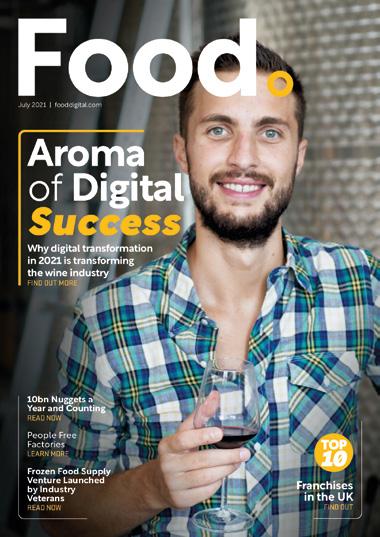































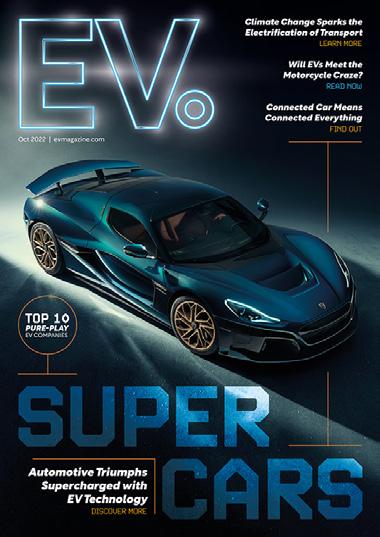




































































Connected infrastructure enables data sharing, but what happens with it? Arcadis Transport Innovation Director Tim Strong tells us more
Digital connectivity is, these days, ubiquitous and now plays a significant role in mobility. For consumers, this enables better visibility of the road conditions ahead, delays to public transportation, or, in the era of EVs, insight into charger locations and availability.
Drivers are at the heart of connected infrastructure, which is integral in moving the world forward sustainably and economically. But the level of data shared today is leveraged in the corporate environment as well.
The data revolution enables businesses to acquire more data on consumer patterns, trends, and individualise them to uncover their specific needs. With connected infrastructure, this level of insight extends to mobility and how drivers move and interact with their vehicles.
To paint a real picture of the current use of connected data, we turn to an expert in the field of digitised mobility, Tim Strong, Transport Innovation Director at Arcadis. Strong shares a holistic view of connectedvEV infrastructure and this integrates into the e-mobility landscape.
Starting with connected data, Strong explains how data and insights enable businesses to maintain their hardware, but also how consumers can leverage this to optimise their EV usage.
“Over-the-air software updates for charge points means CPOs can improve systems more quickly and cheaply than requiring site visits, delivering better customer experience,” says Strong.
“Zapmap’s app maps the majority of public charge points and states that is shows live availability for about 70% of them. This helps drivers plan their routes and stops. Zapmap uses crowdsourced data as one of its sources.
“Apps – for example, Pod Point – enable charging at public charge points without the need for cards or key fobs.”

“OVER-THEAIR SOFTWARE UPDATES FOR CHARGE POINTS MEANS CPOS CAN IMPROVE SYSTEMS MORE QUICKLY AND CHEAPLY THAN REQUIRING SITE VISITS”



UK-based company Zap-Map proves a great example of how data and connected infrastructure can serve drivers. Similar to other map applications, Zap-Map provides 70% accuracy of insights into the UK’s charging network, such as the chargers on route and whether they are available.

Some of the key features of Zap-Map include:
• Map of public charging points: Zap-Map has the most comprehensive map of public charging points in the UK, with over 120,000 points listed. The map is updated regularly to ensure that drivers always have the latest information.
• Real-time status information: Zap-Map provides real-time information on the status of charging points. This means that drivers can see whether a charger is available and in use, before they arrive.
• Route planning tools: Zap-Map's route planning tools help drivers find the best route to their destination, taking into account charging points. This is particularly useful for preventing ‘range anxiety’ on long journeys.
• Community forum: Zap-Map has a community forum where EV drivers can share tips and advice. This is a great resource for new EV drivers, who can get advice from more experienced drivers.
Strong also anticipates that future innovations like wireless charging could also provide further data points for businesses. Connected energy is shaping how consumers interact with charge points as smart charging becomes a crucial component of EV operation.
“Vehicle-to-grid (V2G) smart charging is where energy can flow in two directions, from the grid to EV batteries and from EV batteries back to the grid. This allows the grid to access additional energy to meet peaks in demand, while EV owners still have control over when their EV is charged and ready to use.
“If wireless charging solutions achieve mass market scale, then one could imagine a data exchange between the charger and the
vehicle to identify the vehicle, the associated payment details and charging would be initiated without the need for cards, apps etc,” says Strong.
More data means more opportunity. As the new gold of the century, data provides businesses with focus points for their marketing efforts, product developments, and overall approach to the customer.
By understanding customer behaviours, businesses are able to make more educated decisions to direct their commercial efforts. Customer insights allow for a better user experience while vehicle insights influence OTA updates – this is all supported by connected infrastructure.

“We are living through a paradigm shift, moving from a mature fossil fuelled state, through a change state. The EV market and specifically customer behaviours, are developing and emerging. It will I suspect be some time before we reach another steady state,” says Strong.
“The more granular the data we have on customer behaviour – such as chargepoint utilisation and vehicle state of charge – the better we can plan and manage the charge point networks. Charge point utilisation, state of charge, and fleet movement data could be monetised with organisations from both the public and private sector needing to make investment decisions. In addition, and subject to GDPR, digital marketing and advertising opportunities could emerge from this source of customer, demographic, and movement data.”
Solutions that prove beneficial to homeowners, including smart energy management between car and home, also allow companies to generate revenue streams through energy trading while maintaining financial benefits for the customer.
“Vehicle-to-grid (V2G) smart charging applications could allow businesses to generate small amounts of revenue by trading in energy, either by buying from the grid when prices are low and selling
TIM STRONG

“VEHICLE-TOGRID (V2G) SMART CHARGING APPLICATIONS COULD ALLOW BUSINESSES TO GENERATE SMALL AMOUNTS OF REVENUE BY TRADING IN ENERGY”
TRANSPORT INNOVATION DIRECTOR, ARCADIS
to the grid when prices are higher, or generating surplus green energy and selling it to the grid,” Strong says.

Through a variety of connected applications, data is vital to providing some of the latest solutions to consumers that improve their livelihoods, and are a result of digital integration with energy solutions and vehicles. As businesses unlock the capabilities of this data, they must continue to do so in a noninvasive way.
But, as more data emerges, it holds the key to accessibility, sustainability, and financial benefits for both business and consumer.
TIM STRONG TRANSPORT INNOVATION DIRECTOR, ARCADIS
“WE ARE LIVING THROUGH A PARADIGM SHIFT, MOVING FROM A MATURE FOSSILFUELLED STATE, THROUGH A CHANGE STATE”



























t’s not very often you can sum up a conversation in a one-liner that addresses both the challenge and opportunity at the same time.
“Battery swapping is the answer to the question everyone's been asking: ‘show me an electric car that I can recharge as quickly as I can refuel my petrol or diesel car, and I'm interested’.”

This was an exciting conversation to have with Managing Director for NIO UK, Matt Galvin, who indulged us with some insights from the company, which just so happens to be the first to successfully bring battery-swapping technologies to the EV market. And what a way to do it – releasing a car that functions seamlessly with a Power Swap Station and packaging this all together with autonomous solutions that take care of the work for you.
In essence, NIO has exceeded the expectations alluded to in the aforementioned quote, because with a NIO, the driver has the option to charge the car hands free. In fact, the driver does very little in the battery swapping process. Changing the battery of any NIO vehicle can be achieved from the car and is fully automated, meaning the car itself will align with the Power Swap Station to ensure a successful change of component.
Plug-in charging is the new convention as battery swapping grows & shows potential for wider use while introducing flexibility through battery-as-a-service
And with success being a key word when talking about NIO, the company has already delivered over 1,500 Power Swap Stations globally and completed more than 22 million battery changes since inception.
But, before getting into the details of NIO’s success, it’s important to readdress the challenges that it set out to overcome. The company’s efforts to develop the Power Swap solutions – accompanying some very hi-tech, electrified automobiles—are all in favour of changing the EV narrative from one fuelled by range anxiety to allowing drivers more freedom.
“From a user perspective, it really does provide a real sense of freedom, deep reassurance – and takes away a lot of the anxiety that sometimes is associated with EV ownership – when you know that, actually, recharging your car is as quick and as convenient as refuelling your petrol or diesel car,” says Galvin.
 M ATT GALVIN MANAGING DIRECTOR, NIO UK
M ATT GALVIN MANAGING DIRECTOR, NIO UK
“WE’RE GOING TO TAKE THIS BATTERY SWAP TECHNOLOGY TO MORE MARKETS UNDER THE NIO BRAND”
There should be no borders when it comes to electric travel That’s why IONITY operates charging stations along European motorways that are open to electric vehicles of any brand With several charging points at each location With ultra-fast charging stations that recharge your vehicle’s batteries for the next stretch of your journey in the shortest time possible And with electricity generated exclusively from renewable energy sources So, you are not only travelling emission-free: the journey really is carbon-neutral Find out more here: weareonit.biz

It seems that technology has done it again; digital solutions have provided us with a sustainable option to recharging vehicles while also balancing the energy demand placed on the grid.

“It's a really great technology. The current Power Swap Stations are not only very technologically advanced in terms of their ability to serve our users, but more importantly are very sustainable. They can offer load-balancing capabilities to the grid so that, when there's a high load on the grid, they can actually supply power back into it,” says Galvin.
Well, “wait” being kept to a minimum, the NIO Power Swap station takes just five minutes to fulfil its function. Not only is it a no-brainer for those that own a NIO, but the battery swapping solution is something that we’re yet to see leveraged more widely in the EV market.
Offering what is called “battery-as-a-service” makes NIO the first ever to democratise this for EVs, but it will also pave the way in developing further solutions as the leader in this space. The Power Swap offer allows customers to choose from a few different services, including charging and swapping, as well as upgrading their batteries, which gives them a level of flexibility to use what they need.
By offering an upgradeable solution, customers are able to swap out their smaller batteries for much larger ones when taking a long trip or their overall use of the car increases.
M ATT GALVIN MANAGING DIRECTOR, NIO UK
“WE FIRMLY BELIEVE THAT IT’S THE RIGHT THING TO DO FROM NOT ONLY A SUSTAINABILITY AND ENVIRONMENTAL PERSPECTIVE, BUT ALSO FROM A USER PERSPECTIVE”

What’s important to point out is battery swapping stations are merely the mechanical and technological catalysts for a service that adheres to sustainable principles, and provides drivers with greater confidence in their EVs. The battery-as-aservice model is one that is likely to grow and could potentially become the favoured choice for a lot of EV owners.
It seems that what NIO has created ticks all of the boxes on the electrification list as it addresses driver range anxiety, balances
M ATT GALVIN MANAGING DIRECTOR, NIO UK
“SHOW ME AN ELECTRIC CAR THAT I CAN RECHARGE AS QUICKLY AS I CAN REFUEL MY PETROL OR DIESEL CAR, AND I'M INTERESTED”
demand to enable sustainable energy usage, and will also optimise batteries by creating a shared culture around the Power Swap solution.


As the rollout of battery swapping accelerates, customers will begin to see this solution globally as NIO intends to take this pioneering solution to new markets.
“We’re going to take this battery swap technology to more markets under the NIO brand. And we’re open to cooperating with other brands and companies to share this technology and increase the uptake of battery swapping,” says Galvin.
“We firmly believe that it’s the right thing to do, not only from a sustainability and environmental perspective, but also from a user perspective.”
NIO is in a unique position to drive a new outlook on EVs and the infrastructure that organisations provide to drivers across the globe. By sharing its out-of-the-box thinking with new companies and countries, the Power Swap solution – along with similar solutions – could reshape the way EV drivers charge their cars, and could even help adopt a faster, more convenient approach than what we’ve seen for decades with ICE vehicles.
The Global Sustainability Awards 2024 will be celebrating the very best in Sustainability & ESG with the following categories:

Sustainability Strategy Award
–
ESG Program Award
–
Climate Change Award
–
Diversity & Inclusion Award
–Net Zero Award
–
Sustainable Supply Chain Award

–
Sustainable Technology Award
–
Sustainable Consultancy Award
–
Future Leader Award
–
Executive of the Year Award
–
Project of the Year Award
–
Lifetime Achievement Award

Conversion is a new concept for enabling zero-emission propulsion in older cars, but how would such a solution fare as a fleet option?


Having seen many scenarios where ICE cars are preserved or even resurrected by means of electric conversion, it’s about time we think about its applications across industries where switching to EVs is becoming the next big step.
From the development of an electrified Aston Martin DB6 by Lunaz Design, to now welcoming businesses into the arena that deals with conversions and even offers full kits for swapping out fossil-fuel power for all-electric – this is what sparked a need to cover ICE to EV conversion, as well as its applications among large vehicle fleets and operations.
“The conversion of fleet and logistics vehicles to electric power presents numerous applications and benefits in transportation and logistics,” says Chris Hazell, Co-Founder and CEO at Fellten— an organisation developing kits to convert classic cars from ICE to electric.

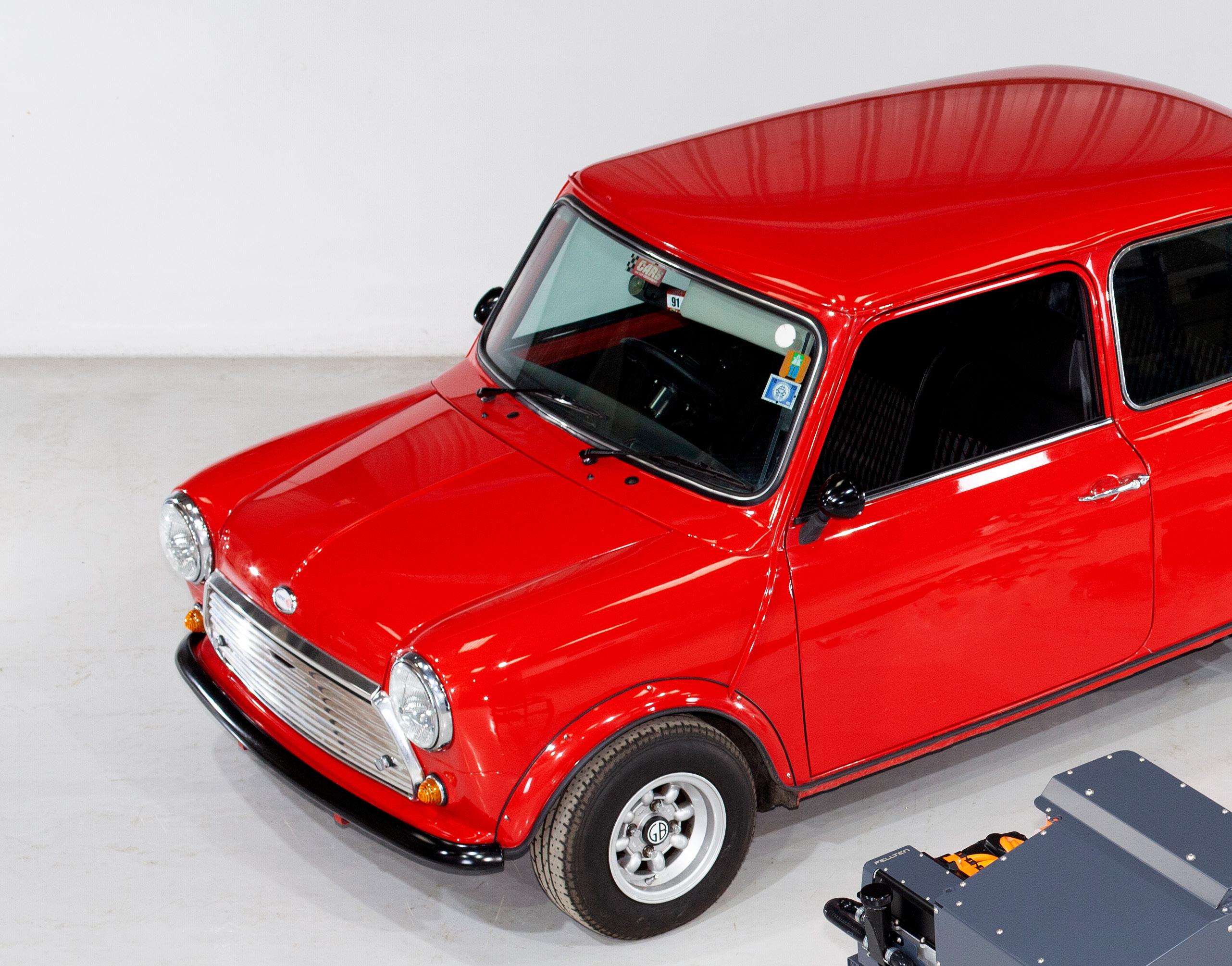
“The potential applications are vast, focusing on light to medium-duty pickup trucks and utility vehicles, ranging from urban and last-mile delivery to large infrastructure industries (tunnel building, mining, etc.).”
Of course, converting a fleet of vehicles would be a major adaptation in itself, but the cost of doing so may outweigh that
of buying commercial electric vehicles. Currently, the cost of purchasing an EV is significantly higher than its fossil-fuelpowered equivalent in the conventional class of models.
Taking the example of the Ford Transit, one of the most popular commercial vehicles on the market, we can see the purchase price of the vehicle is around £36,000 (US$44,765) for the engine-powered model – but the base level electrified version starts at £45,000 (US$56,000).
Taking this factor into account, it wouldn’t come as a surprise to see more vehicle retrofitting services to provide lower-cost EV adoption alternatives.
“Retrofitting delivery and specialised or custom-equipped light-duty vehicles typically costs less than purchasing new electric vehicles and equipping them with new, to-bedesigned, special accessories (Ambulances, military, mobile workshop, etc.),” says Hazell.

“The retrofitting allows for the continued use of already-owned assets. This approach reduces waste, promotes resource efficiency, and helps extend vehicles' lifespan. Retrofitting also offers a high degree of flexibility and customisation.”


There are, however, some other factors to consider with aftermarket solutions, the first couple being the value of the vehicle and insurance premiums.

Much like any other modification to a vehicle, it’s yet to be recognised how retrofitting fleet vehicles would affect insurance and the overall sale value. What could potentially be a cost-saving option may also present repercussions, as assets may be valued much lower if they have been altered from their factory architecture.
A further point to be made here is whether car makers will be able to provide conversion
kits to garages as the majority of EVs are now based on a different architecture – with batteries in the floor and the difference in weight between EV components and ICE.
This would also throw out questions related to autonomy and the ability to integrate converted vehicles into a wider strategy for autonomous fleet operation, which is a trend that continues to grow among fleet managers. The latest vehicles are not only enabled for connectivity, but, at organisations such as Waymo and Einride, they are leveraging more and more autonomous capabilities to bring their vehicles closer to driverless.
This may not be a concern for businesses that also wish to reap the benefits of AI as more and more businesses are adopting new technologies to enable autonomous functions. Perhaps this will pave the way for bolt-on autonomous solutions for the commercial environment.

Nevertheless, this is a point for the future as the initial dilemma that companies are faced with requires them to change the times and incorporate electrified or other zero-emission formats into their fleets. Speaking of alternatives, battery-electric power may not be the only option.
The birth of the hydrogen fuel-cell vehicle has only sparked questions around the use of the fuel, which, if managed correctly, could prove to be another alternative to fossil fuels with zero carbon emissions.
Hydrogen-powered vehicles can not only operate on lower quantities of richer hydrogen fuels, but they also allow combustion at lower temperatures. Hydrogen is lighter than conventional fuels and has an incredibly high gravimetric energy density – which, in layman’s terms, means it weighs a lot less.

However, the volumetric weight of hydrogen influences another problem: the quantity of fuel required to increase vehicle range. Retrofitting hydrogen storage could present as the major hurdle in converting fossil fuel cars to hydrogenbased ones. Car makers may also struggle to convert cars to hydrogen that are not factory-fitted with direct fuel injection, which is a suitable form for hydrogen, but very new in the automotive market. Without this type of injection, hydrogen cars run the risk of pre-ignition, presenting as one of the major safety concerns among manufacturers.

So there are certainly some options to be considered for fleet vehicles, particularly as electric and hydrogen conversions are already in research and development, but time will tell whether these options are feasible – at least until the cost of new EVs is reduced.





Does the Munro MK_1 top its ICE competitors when it comes to reliability and performance in the toughest environments?
Amajor task involved in energy transition is answering questions. How will we charge? Will EVs meet our range requirements?
What about those in rural areas?
Although urbanisation has helped to develop settlements into fully-fledged towns and cities, or connect distant areas via road networks, there still remains around 35% of the global population that live and work in rural areas.
Bringing cars into the electrified digital era is all well and good, but sometimes infotainment, holographics, additional comfort – they’re all just too much for the user. Car companies often think about the must-have technologies, but, realistically, there’s a vast swathe of people that just want to use their EVs to travel anywhere, anytime.
Sure, there’s an abundance of space for technology and its uses, and the idea of instant torque is a dream for many drivers… but what about off-road capabilities?
“Traditionally iconic 4x4s, which for years were the off-road vehicle of choice for commercial and private users, are no-more. They have been retired and replaced with more modern, car derived vehicles positioned as lifestyle choices and luxury vehicles,” says the Head of Sales at Munro, Marcus Mackle.
“For fleets with off-road needs and private enthusiasts, these modern vehicles no longer provide an equivalent level of capability. They are seen as a commodity: cheap and frequently replaced when they break, which they inevitably do even outside the harshest of operating environments.”




The key point here for Munro being “the harshest of operating environments”, which paints a picture of what the company is all about: catering for a market that wants the durability and longevity that, historically, offroad vehicles have provided.

A great example of rugged vehicle design can be found in the likes of the Land Rover Defender and its variety of models, which is built for function and, despite its diesel propulsion, has provided customers with service to this day.

Cue Munro: a solution to meet the needs of commercial fleets and customers alike facing tougher environments.

“FOR FLEETS WITH OFF-ROAD NEEDS AND PRIVATE ENTHUSIASTS, THESE MODERN VEHICLES NO LONGER PROVIDE AN EQUIVALENT LEVEL OF CAPABILITY”
MAR CUS MACKLE HEAD OF SA LES, MUNRO
“Every large fleet faces the challenge of electrifying their vehicles and machinery,” says Mackle.
“The drive to decarbonise, particularly in heavy and carbon-intensive industries –coupled with ESG pressures and a desire to take advantage of the lower cost of ownership of EVs – means commercial fleets, landowners and operators are without an option. They’re crying out for a true 4x4 that’s all-electric and zero emission. This is why Munro exists.”
Munro vehicles recognised the trend in electrification. Born in the Scottish Highlands, the company is well-positioned and wellequipped to build a vehicle that can tackle the harshest of terrains and climates.
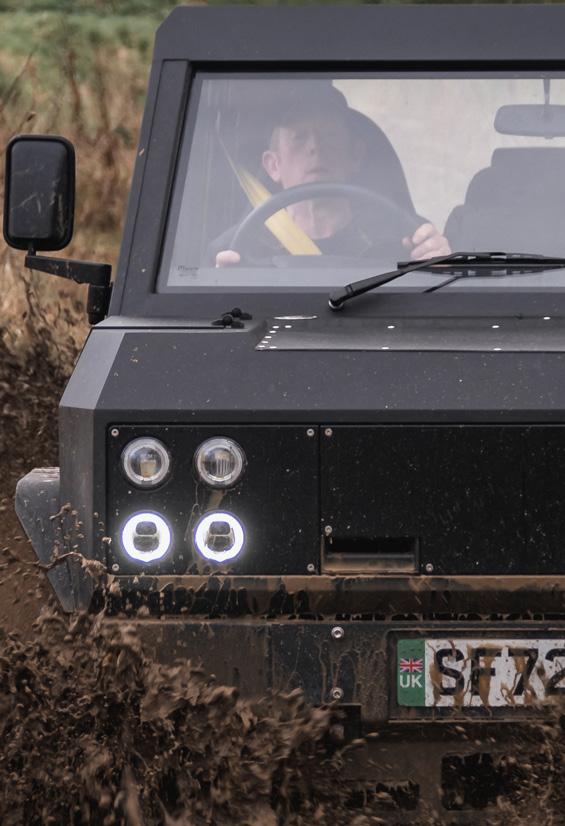

With a 61.2kWh battery and a motor that puts out 220kW, the Munro MK_1 EV comes in three optimised variants: utility, range, or performance. It’s not your average vehicle. It’s not built as a high-end city run-around or a commuter. The Munro EV will service those working in mountain and rural response units, and can be applied to infrastructure and industrial operations and land management.
The Munro MK_1’s simplistic, functional design makes it the electrified modern competitor of the Land Rover Defender.
“In Scotland, we have tackled rugged Highland trails, traversed roaring rivers and headed-up steep gradients that other 4x4s simply could not. In harsh conditions of torrential rain and morning fog, the MK_1 takes the operator over these rolling hills with ease,” says Mackle.
The ability to meet the demands of a sustainable future doesn’t necessarily hinge on the luxuries and autonomy that electrification brings. While there are many use cases for autonomous vehicles and self-driving cars to allow more comfort for extended journeys, there’s still demand for the basic functions.
Countries like Scotland, Australia, Canada, and the African continent, among others, are able to provide crucial services with the vehicles they have today, but it’s great to recognise that an EV can provide them with the same great capabilities – and it does that with zero emissions. All that’s left is to ensure that vehicles are able to charge and retain their power in the most rugged settings.

“Charging infrastructure in the UK is evolving rapidly and this will aid the integration of Munro technology into rural environments even more so than currently possible,” says Mackle. “Home charging stations are becoming a popular choice of home improvement with many incentives on the market, for end users/operators of the Munro this is a huge benefit too.”

“TRADITIONAL, ICONIC 4X4S –WHICH, FOR YEARS, WERE THE OFF-ROAD VEHICLE OF CHOICE FOR COMMERCIAL AND PRIVATE USERS – ARE NO-MORE”
MAR CUS MACKLE HEAD OF SA LES, MUNRO

E-mobility is a global concern, but this varied list of 10 service providers shows the breadth of electrification as a sustainability initiative
Mobility is a very broad term, but the elements of it are the same – electrified solutions, smarter transport, and accessibility.
The Top 10 e-mobility service providers vary greatly, but carry this same drive to create a sustainable mobility network with electric power at the heart of it. From charging infrastructure and information sharing to shared micro-mobility, these businesses are all integral to the smart cities of the future and clean transportation, globally.

Taking the two-wheeled EV market to a completely new level, Ola Electric is responsible for electrifying the moped market as a solution to damage caused by city congestion.
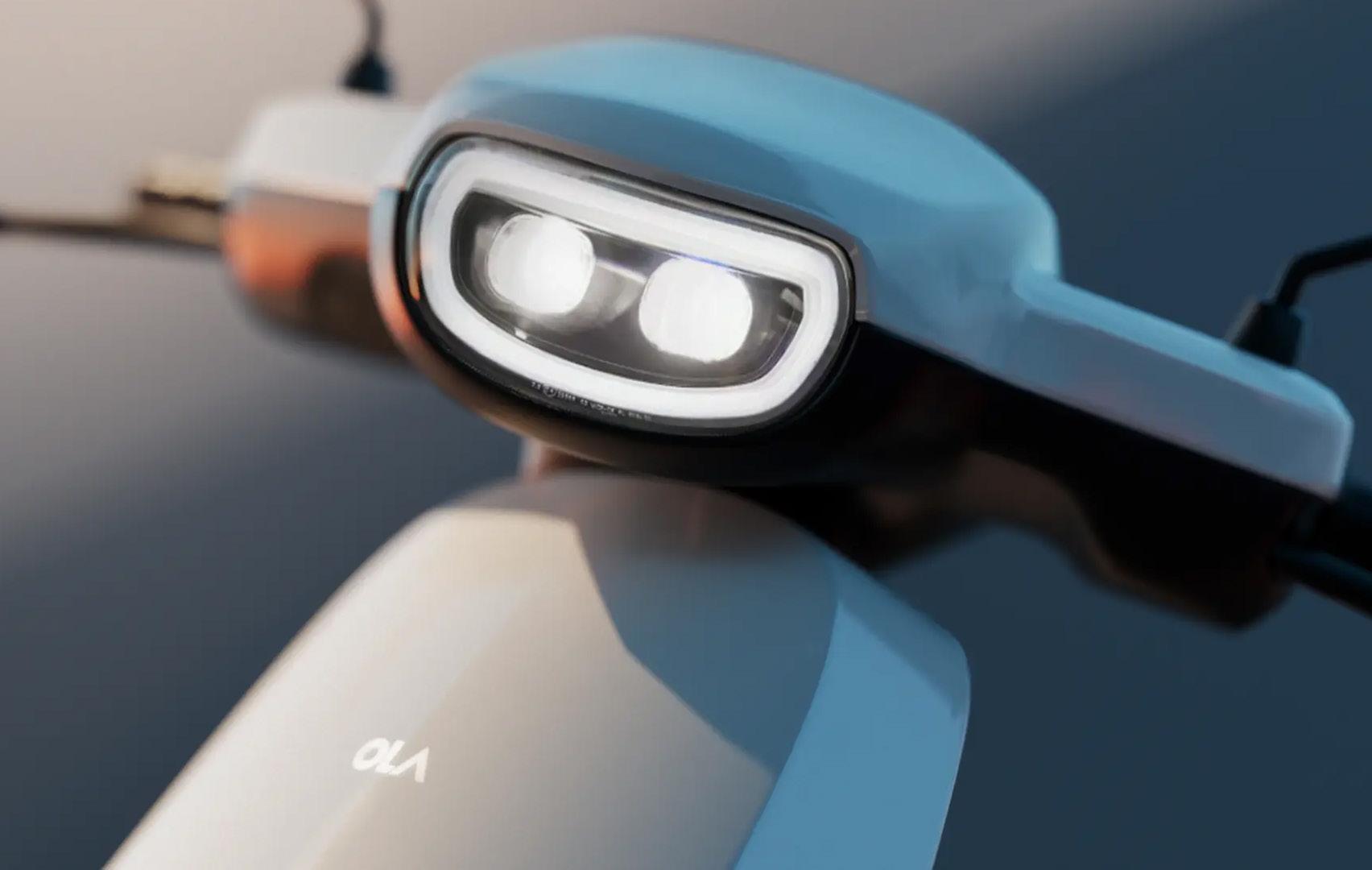
The Indian two-wheeler manufacturer was founded in 2017 by Bhavish Aggarwal, and is based in Bengaluru, Karnataka. The company’s impact comes from providing cost-competitive, well-performing mobility solutions for the masses –particularly in India, where mobility is a critical factor in sustainable growth.


Citymapper was founded in 2011 by Azmat Yusuf and Oriol Vila. As a public transit and mapping service app, Citymapper serves a global population with uses on over 30 international cities, including London, New York, Paris, Berlin, and Tokyo.
In 2021, the company raised US$250m in Series D funding – increasing the overall value of the business to US$1.1bn – which will be leveraged to develop its user-friendly app, incorporating more cities and new features like traffic updates and ride-hailing.

The dockless e-bike and e-scooter sharing business was founded as a startup in 2017 and later acquired twice in its first five years. The company was first nestled in the Ford portfolio before TIER Mobility’s takeover in 2022.
Operating in 70 cities and campuses across the US, Canada, Australia, and Europe, Spin is a sustainable initiative that enables commuters to move around cleanly and efficiently at a lower cost. By subscribing to Spin, customers can gain an unlimited number of rides each month, which provides significant ease of sustainability.
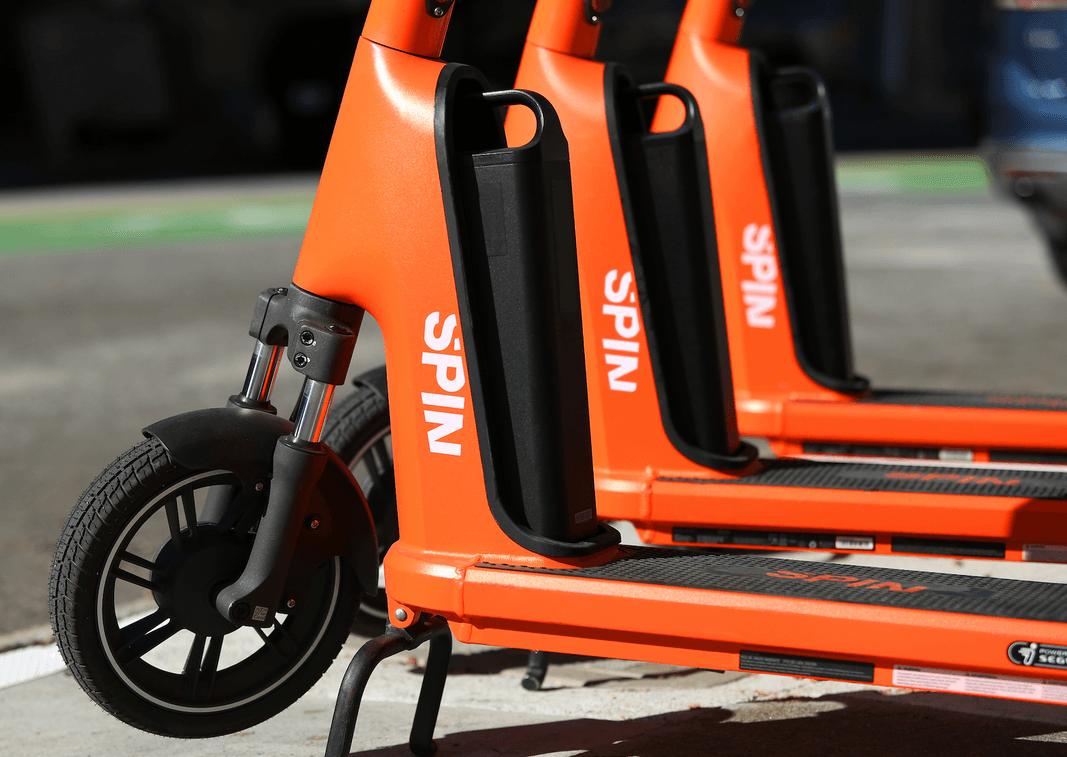

Car sharing is the way to go for more and more commuters, which is why Zipcar’s solution hits the demand at an inflection point. Founded in 1999, the company’s services provide for more than 10 million members across 500 cities and towns, spanning Europe, Canada, and the states.


The Zipcar service allows more commuters to save money while also selecting a transport solution that equates to less overall emissions, and makes travel more affordable for its users.

A crucial service to many businesses and consumers, ChargePoint has installed more than 18,000 chargers across the United States and other countries, leading to more than 100,000 charging ports. It’s the largest and most open EV charging network globally, paving the way for more sustainable transportation by supporting the development of necessary infrastructure and charging capabilities. The company is also working with EV hardware makers and charge point manufacturers to optimise their solutions.


From bikes to cars, Lyft is the US-based mobility service that provides all the solutions to let its customers decide whether they want to talk transportation into their own hands or share it with others. In the Fiscal year of 2022, Lyft’s revenue rose to US$4.1bn, which is a 28% year-on-year increase.
First founded as a ride-hailing business, the company has now ventured in the dockable e-bike and e-scooter race, as well as providing rental car solutions and food delivery across the US and some cities in Canada.

As one of the world’s leading mobility technology platform providers, DiDi Global offers a multitude of app-based services to support electrification across APAC, Latin America, Europe, and Africa. In 2022, its ride-hailing service, DiDi Chuxing, was valued at 141 billion yuan (over US$20bn).
As part of its service, the company also provides taxis, chauffeurs, and other forms of shared mobility solutions, as well as food delivery and freight.


Rethinking urban mobility, Bird is now available across parts of the US, Europe, and The Middle East. The company provides e-bikes and e-scooters in a multitude of services to cities and university campuses where transport is easier and cheaper via personal, micro-mobility methods.
The team is also committed to growth through supporting cities to adopt electrified solutions, enhancing mobility in a sustainable way.


Lime operates e-scooters across 150 cities in more than 30 countries. Providing convenience and affordable transport to the masses, it’s yet another electrified solution for commuters to use on the fly – carbon free. Whether exploring a new city or just travelling to and from work, Lime e-scooters have proven successful in areas where there is limited demand from consumers to own their own. The business was also the first of its kind to become profitable, which it achieved in February 2023, having experienced a year-onyear growth of 33% to exceed US$450m.
In doing so, the company’s e-scooters were used for 120 million trips in 2022, equating to around four rides every second.




Uber is a ride-hailing company that is committed to sustainability. It has a goal of becoming a zero-emissions platform by 2040. To achieve this goal, Uber is investing in electrification, which is evident in its commitment to net-zero emissions, and will begin by switching its current London-based fleet of 45,000 cars to allelectric vehicle models.

By educating drivers and customers on the benefits of ZEVs and the roadmap towards sustainability, Uber hopes to bring all on board with its electrified vehicle strategy.

CATCH THE LATEST UPDATES AND RECEIVE EV NEWS INSIGHTS


